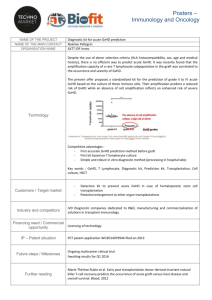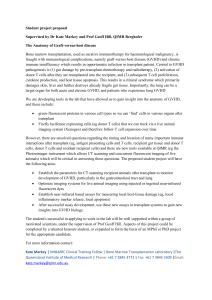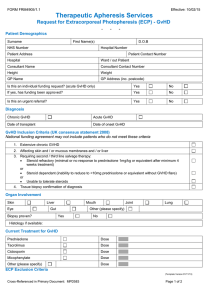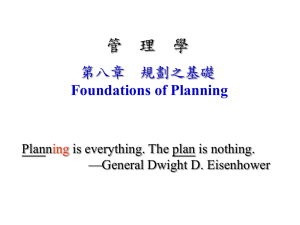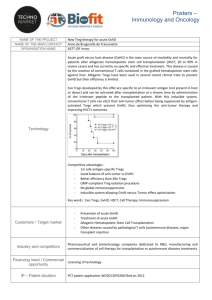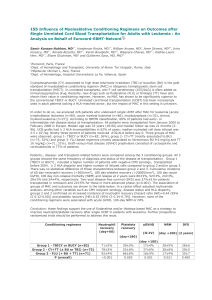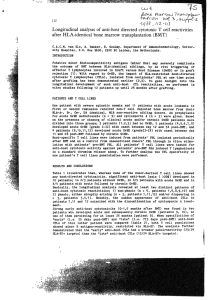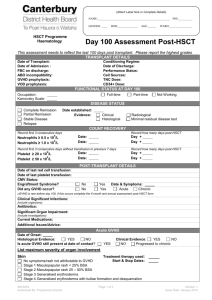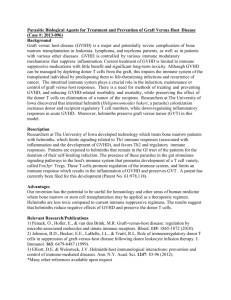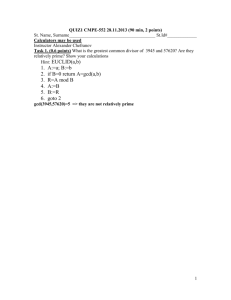Supplementary Information (doc 53K)
advertisement
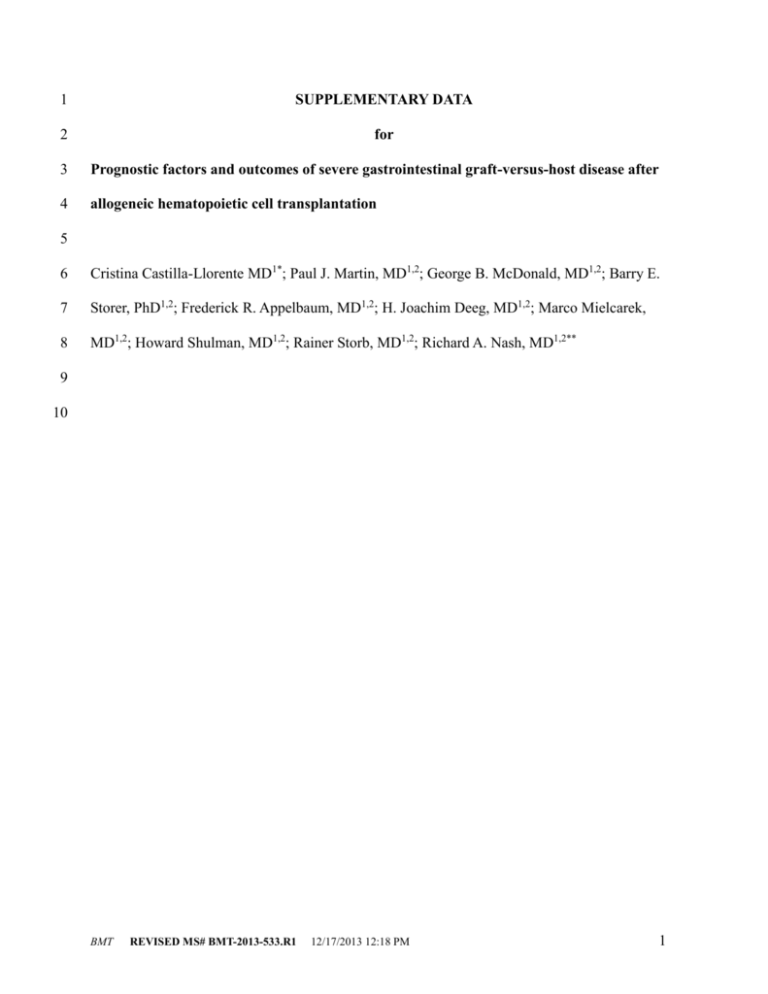
1 SUPPLEMENTARY DATA 2 for 3 Prognostic factors and outcomes of severe gastrointestinal graft-versus-host disease after 4 allogeneic hematopoietic cell transplantation 5 6 Cristina Castilla-Llorente MD1*; Paul J. Martin, MD1,2; George B. McDonald, MD1,2; Barry E. 7 Storer, PhD1,2; Frederick R. Appelbaum, MD1,2; H. Joachim Deeg, MD1,2; Marco Mielcarek, 8 MD1,2; Howard Shulman, MD1,2; Rainer Storb, MD1,2; Richard A. Nash, MD1,2** 9 10 BMT REVISED MS# BMT-2013-533.R1 12/17/2013 12:18 PM 1 11 Supplementary Table 1. Data collected for this study* Parameter Description Stages/Grades Gut GVHD stage A peak stage was assigned based on volume Stage 0 - ≤500 ml; of diarrhea and clinical signs. Stage 1 - 500-1000 ml; Stage 2 - 1000-1500 ml; Stage 3 - >1500 ml; Stage 4 - severe abdominal pain (cramps)† or melena. Skin GVHD stage A peak stage was assigned based on the Stage 0 - No involvement; extent and severity of the rash. Stage 1 - <25%; Stage 2 - 25-50%; Stage 3 - >50%; Stage 4 Generalized erythema with bullae. Liver GVHD A peak stage was assigned based on the level Stage 0 - <2 mg/dl; stage of serum bilirubin and exclusion of other Stage 1 - 2.0-3.0 mg/dl; causes of abnormalities in serum bilirubin. Stage 2 - 3.1-6.0 mg/dl; Stage 3 - 6.1-15 mg/dl; Stage 4 - >15 mg/dl Upper GI Presence or absence of any of anorexia, symptoms nausea or vomiting. Gastrointestinal Presence or absence of frank red blood or bleeding melena in the stools. Endoscopic grades Endoscopic grading was based on the visual Grades 0 - normal appearance; of GVHD in upper findings at endoscopy previously Grade 1 - edematous or and lower described16,40 erythematous changes; no gastrointestinal ulcerations or erosions; tract Grade 2 - friable mucosa, focal erosions or ulcerations; Grade 3 - extensive confluent BMT REVISED MS# BMT-2013-533.R1 12/17/2013 12:18 PM 2 Parameter Description Stages/Grades erosions or ulcerations. Histopathological As previously described16,26,41 if more than Grade 0 - normal mucosa; Grade 1 - grades of upper one endoscopy was performed in the same presence of apoptosis without crypt and lower 14-day interval, the highest grade for GVHD (or basilar gland) loss; gastrointestinal histology was assigned. Grade 2 - individual crypt (or basilar GVHD gland) loss; Grade 3 - contiguous areas of crypt (or basilar gland) loss with or without presence of focal regenerative hyperplasia; Grade 4 - complete loss of crypts (or basilar glands). Grade of GVHD The grades were based on the extent of Grade 0 - Normal; Grade 1 - based on involvement. Regional wall thickening in either abdominal CT the small or large intestine; imaging Grade 2 - Extensive wall thickening in both the small and large intestine 38. Infections Infections of the gastrointestinal tract confirmed by cultures or biopsy including cytomegalovirus, C. Difficile or other infections. GVHD treatment: Immunosuppressive agents used for treating GVHD were noted for each of the 14-day intervals including any relevant change in the dose of corticosteroids or the addition of other systemic therapies. Data on the use of topical therapies was not collected. Serum albumin The nadir of serum albumin was noted for each consecutive 14-day interval (mg/L). BMT REVISED MS# BMT-2013-533.R1 12/17/2013 12:18 PM 3 Parameter Description Stages/Grades RBC transfusion Number of red blood cell units transfused for each 14-day interval. Total parenteral The number of days on TPN in each 14-day nutrition (TPN) interval. Hospitalization The number of days for which hospitalization was required for supportive care. 12 *Each parameter was collected as either presence/absence or peak/nadir values for each 14-day 13 interval from 14 days before onset of stages 3-4 gut GVHD. 14 † 15 Cramps were defined as abdominal pain requiring intravenous narcotics. BMT REVISED MS# BMT-2013-533.R1 12/17/2013 12:18 PM 4 16 Supplementary Table 2. Survival at 6 and 12 months according to the number of risk factors Number of Risk Factors* Number of Patients 6 Month Overall Survival (%) 12 Month Overall Survival (%) 0 or 1 18 83 72 2 30 73 57 3 35 26 11 4 33 0 0 17 *Risk factors for overall survival were identified in the multivariate analysis and are: 1) serum 18 bilirubin >3.0 mg/dL, 2) corticosteroid-resistant, 3) patient >18 years of age at transplant and 4) 19 gastrointestinal bleeding. Overall survival decreases as the number of risk factors for poor 20 outcome are increased. 21 22 23 BMT REVISED MS# BMT-2013-533.R1 12/17/2013 12:18 PM 5

